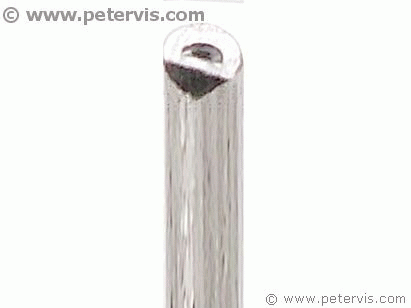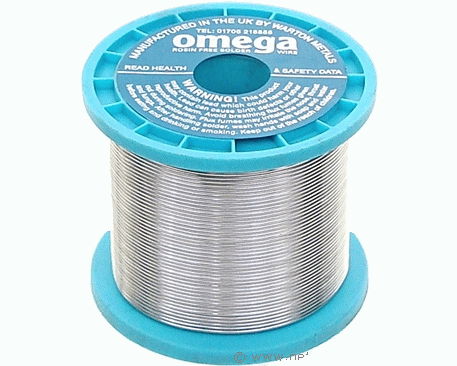Choosing the Right Solder Wire
Choosing the correct solder used to be simple, however, today you can obtain a wide variety of solders for different tasks. When choosing, you need to be aware of the lead content, flux content, melting point temperature and size. In the old days, radio and television engineers used the 60-40 solder mix. This consisted of 60 % tin and 40 % lead, however lead free solders are also available. It is also possible to buy solders that are rosin free, which is good news for your health. In these types of solders, instead of rosin, they use a different type of flux chemical. Unless your classroom has special LEV ventilation system for extracting fumes, it is probably better to get solders that do not produce harmful fumes. Anything that is ROHS compliant tends to be recommended solder for electronics use, however, in my view, the best solder for schools and non critical applications ought to be lead free, rosin free and halide free. With an increase in the number of reported worldwide cases of asthma, many schools are now buying rosin free solders. In addition, the recent ROHS regulations now mean that they have to look for lead free solders as well. Since halides are not much good for you either, the choice narrows down to a few solders such as Omega. Lead free and rosin free solders have been around for many years but it is simply a question of educating the educators.
Best Size Solder
For basic electronics work, a solder wire approximately 0.711 mm to 1.63 mm in diameter is good enough. However, solder diameter is determined by the gauge number. Your basic average student will be working with through-hole PDIP packages, hence gauges that work well are 18, 20, and 21. Staying within this range is probably a good idea for beginners as there is less chance of creating bridges or wasting solder.
| Gauge Number | 16 | 18 | 20 | 21 | 22 |
| Diameter (mm) | 1.63 | 1.22 | 0.914 | 0.813 | 0.711 |
| Diameter (inch) | 0.064 | 0.048 | 0.036 | 0.032 | 0.028 |
For example, if you were to order the Omega: Rosin and Lead Free Solder, which is environmentally friendly, then you can order any of the gauges shown above from gauge 16 to 22. However, they manufacture many other gauges not mentioned here, because they also supply to industry. For PDIP and through-hole packages with standard pin spacing of 0.1-inch, I would use gauge 18. If I were to be working on SMD components such as SOIC packages where the pin spacing is much closer, then a fine tipped soldering iron with a 22-gauge solder wire works well. For restoring antique computers for the museum, and repairing vintage circuits that have huge solder tags, I usually use gauge 16.
Temperature Chart
A 60/40 solder is an alloy of 60 % tin and 40 % lead measured by weight. This type of solder has a melting point of around 190 °C. Another commonly used tin / lead solder alloy is 63/37, which has a melting point of 183 °C. I have compiled a Soldering Temperature Chart that might help determine the correct temperature for the type of solder used.
Cored Solder Wire

Cored solder means that there is a hollow core running through the centre of the wire that contains the flux chemical. The typical flux ingredient tends to be rosin and is usually no problem if you have a ventilation system and are not an asthmatic. However, for the rest of the people, there are alternative solders that are non-rosin based and especially developed for schools and colleges.
Choosing the Flux
Flux core solder wire means that there is flux inside the core of the solder wire. The flux prevents oxidation occurring when the oxygen in the air reacts with the hot metal. The oxide forms a covering layer over the metal and prevents the solder from sticking to it. Flux is the chemical that actively removes this oxide and prevents the build up of new oxide. Solders typically use a rosin flux, which is a naturally occurring substance in pine trees extracted in the form of tree sap. It is a very interesting chemical because at room temperature it is inert, however, when heated, it becomes acidic which helps to prevent oxidation. Linked to a number of reported worldwide cases of asthma, rosin can trigger an attack in people who suffer from this condition. Asthma is on the increase in the general population; hence, there has been a steady shift to rosin free flux. Omega uses a new form of flux ingredient that is not only environmentally friendly, but leaves a very clear residue on your PCB that will not require cleaning.
Avionics and Military
For school projects and hobbyist, blinking a couple of LEDs, the use of Omega Standard cored flux solder wire is the perfect choice and you can ignore this section. For mission critical military applications, the use of flux is a concern because flux is acidic, which can affect reliability of a circuit over a long-term period. A missile in an underground complex is required to operate reliably for many decades. You cannot exactly send the cable guy out to fix the dodgy electrical connections every time a red warning light comes on...
The Military Specification QQ-S-571E defines four different types of flux: (R) Rosin, (RMA) Rosin Mildly Activated, (RA) Rosin Activated, and (AC) Non-Rosin Activated. The non-rosin flux tends to be water soluble hence its name has been replaced with (WS) for Water Soluble. All of these different types of fluxes are available in different activity levels. Manufacturers therefore use a less aggressive (less active) flux when building critical circuits. Smaller amounts of flux are used, and the printed circuit boards cleaned of any residue afterwards. It is therefore possible to buy Omega in 3 %, 2 %, and 1 % flux content for mission critical applications.
How much Omega to Order

It is difficult to estimate how much to solder to order, however, generally, it runs out very quickly in the hands of students. In a class of 10 students, if each one had to solder a 16-pin PDIP chip, one resistor, one capacitor, 6 wire points, allowing for waste due to mistakes, and the generous application of solder, a student may use approximately 16-inchs length of 21-gauge solder wire. This approximates to around 0.055 oz of solder per student, and 0.55 oz of solder per class. Schools usually order in bulk directly from the Wartons factory to cover a whole year. This not only saves on postage costs, but also works out cheaper when you order larger quantities.
This Article Continues...
A Soldering Guide for Beginners, Kids, and Electronics StudentsSoldering Guide: Safety Tips
Choosing the Right Solder Wire
How to Solder
Soldering Guide Basics
Soldering SMD Guide
Soldering in Space
How to Choose a Soldering Iron
Omega: Rosin and Lead Free Solder